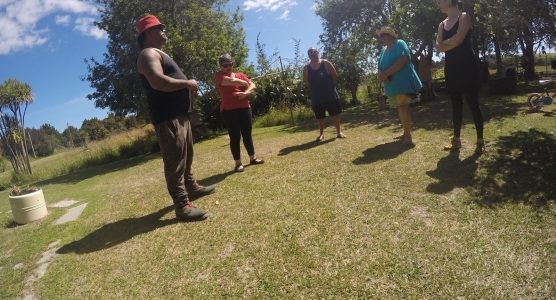22 May Kai Ora Wānanga – Parapara
Kai Māori, Kai ora is the central Toi Tangata nutritional strategy that aims to support the numerous components required for whānau to reach their potential. Kai Māori, Kai ora recognises that there are many different elements to well-being and acknowledges the reciprocal relationship between Te Ao Māori and the way we think, feel, eat, drink and move. One of the recent initiatives around the Kai Māori, Kai ora space supported a whānau led kai-mapping wananga with a group of Ngati Tara whānau at Parapara Marae.
Supported by funding from the Far North District Council, Manaia PHO and Toi Tangata – the wananga also provided the opportunity for workforce development, tauira participation with summer interns, and leadership from Hauiti Haukopa (Otago University). Hauiti provided support with his expertise around mapping, and facilitated parts of the wananga leading small group discussions. Genie Harrison from Ngati Tara, a recipient of a Kai Ora internship scholarship, also assisted with facilitating the process and is developing a Kai Ora, Kai Māori project at Toi Tangata.
Over the two-day wānanga, some of the most valuable and enjoyable discussions were those that encouraged kuia to describe their experiences of food gathering practices and previous knowledge sources around kai in the area. This relaxed and whānau focused process allowed kuia to reminisce and recount their stories to the younger whānau and interns who treasured the privilege of recording the moment.

Many of the stories about collecting kai were recalled and charted using the local awa as a reference point. One group led by a kuia recorded as many as 25-30 different kai as she mentally traced her way down the awa, identifying key markers along the way, and ending as the awa met Aurere beach. From fruit trees and vines such as apples, peaches, loquats, and grapes, to kai o te ngahere which provided kai rongoa like tawhara flowers (kiekie) or a sweet treat such as the taraire berry, often enjoyed by kereru. The awa itself was described as the local supermarket where mullet could be found upstream and whitebait were also abundant at times.
The process of mapping these stories and identifying the kai along the way was whānau-centred, and aimed at enhancing the mana of the whānau involved and those that they represented from the seven families of the Parapara valley. The first day of the wānanga was wrapped up with half of the group going out to “dive” for pipis for dinner, and the other half exploring some of the nearby kai sources spoken about throughout the day. Both activities proved ideal as enjoyable and practical ways to bring a close to the day.
Day two allowed the practical learning to shift up a gear, after a karakia and water safety briefing, the group set out from Parapara with kayaks bound for Aurere.
The Ngati Tara flotilla consisted of tamariki, tauira, and whānau of all ages ready to explore the river bends, changes to currents and water quality, and to enjoy the chance to engage with the wai. With many adventures along the way, whānau had the opportunity to meander along at their own pace and enjoy the company of others or take the time to reflect and kōrero with the awa in peace. Some of the reflections from the day on the awa would identify the need to take more responsibility for the river, wanting to get to know more about its different parts, and using that knowledge to help restore it to better health.
With the two day wānanga coming to a close, whānau were able to identify some suggestions for how the drafting of a food map would best benefit Ngati Tara. Suggestions ranged from traditional to technological, but all would see whānau engaged in the process of ensuring the knowledge is preserved and passed on. The importance of local mātauranga and capability available within the hapu and local whānau was evident throughout the discussions, reflections and identifying future development initiatives. It was evident that the Parapara whānau have a rich source of skills, developed from varying pathways in life, to create and maintain a successful kai mapping resource that will ensure future generations have the mātauranga and raukaha to thrive.
Nā Debs Heke



